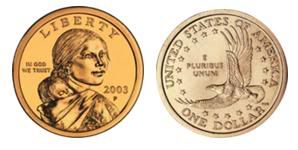Our arrhae

The Sacagawea dollar was authorized by Congress in 1997 because the supply of Anthony dollars, in inventory since their last mintage in 1981, was soon expected to be depleted. Delays in ramping up Sacagawea dollar production led to a final 1999-dated mintage of Susan B. Anthony dollars. As predicted by Coin Coalition representatives at Congressional hearings on the United States $1 Coin Act of 1997, the government's failure to eliminate the U.S. one dollar bill prevented the Sacagawea Dollar from being widely circulated. While dollar coins are used infrequently in general commerce, they are used in place of tokens in some areas and are given as change in many United States Postal Service stamp vending machines, creating a relatively small but significant demand.
The obverse was designed by artist Glenna Goodacre, using Shoshone Randy'L He-dow Teton as a model for Sacagawea [1].
There are approximately 1 billion Sacagawea coins in circulation and about 250 million more in reserve. The United States Mint greatly reduced production of Sacagawea Dollars after the 2001 minting, citing sufficient inventory. As of 2005, The Mint continues to produce circulation and proof quantities of the coin each year for sales to numismatists.
The Mint took great care to create the coin with the same size, weight, and electromagnetic properties as the Anthony dollar, but with a golden color. Unfortunately, the selected alloy has a tendency to tarnish quite severely in circulation (unlike Canadian dollar coins, which retain their yellowish appearance in circulation), ruining the "golden" effect. Being able to easily co-circulate the coin with the Anthony dollar was considered a higher priority than maintaining a consistent coloring, despite the fact that the Anthony dollar had virtually no circulation and many vending machines had to be recalibrated to accept the new coins anyway.
As of 2006, dollar coins are seldom encountered in commerce in the United States, except in vending machines dispensing tickets, tokens, or cards for rides on mass transit in or near large cities (which offer the coins as change from a $5 or larger bill where necessary) and at casinos, where they are used in slot machines. They are also given as change in stamp vending machines at post offices. However, the Sacagawea dollar has achieved popularity in Ecuador, where the US dollar is also the official currency.


0 Comments:
Post a Comment
<< Home